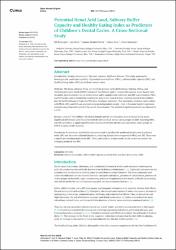| dc.contributor.author | Kibaroğlu, Elif | |
| dc.contributor.author | Kurt, Ayça | |
| dc.contributor.author | Demirel Özbek, Yağmur | |
| dc.contributor.author | Saral, Özlem | |
| dc.contributor.author | Hatipoğlu, Ömer | |
| dc.date.accessioned | 2023-10-25T12:30:43Z | |
| dc.date.available | 2023-10-25T12:30:43Z | |
| dc.date.issued | 2023 | en_US |
| dc.identifier.citation | Kibaroglu, E., Kurt, A., Demirel Özbek, Y., Saral, O., & Hatipoglu, O. (2023). Potential Renal Acid Load, Salivary Buffer Capacity and Healthy Eating Index as Predictors of Children's Dental Caries: A Cross-Sectional Study. Cureus, 15(5), e39513. https://doi.org/10.7759/cureus.39513 | en_US |
| dc.identifier.issn | 2168-8184 | |
| dc.identifier.issn | 2168-8184 | |
| dc.identifier.uri | https://doi.org/10.7759/cureus.39513 | |
| dc.identifier.uri | https://hdl.handle.net/11436/8578 | |
| dc.description.abstract | Introduction: Dental caries is one of the most common childhood diseases. This study purposed to
investigate the prediction capability of potential renal acid load (PRAL), salivary buffer capacity (SBC), and
Healthy Eating Index (HEI) on children's dental caries.
Methods: The decay, missing, filing, and teeth for primary teeth (dmft)/Decay, Missing, Filling, and
Teeth for permanent teeth (DMFT) indexes of the children aged 7-12 years who applied to our faculty were
recorded. Approximately 1 mL of unstimulated saliva samples were collected, and SBC was evaluated. PRAL
and HEI scores were calculated by entering the data in the form of a daily nutrition record of the children
into the BeBiS software (Ebispro for Windows, Stuttgart, Germany). The association of dental caries indices
with PRAL, SBC, and HEI was analyzed using an independent sample t-test. A binomial logistic regression
analysis was performed to predict the dental caries burden. The statistical significance level was adjusted to
a=0.05.
Results: A total of 150 children, 88 (58.6%) females and 62 (41.4%) males, were included in the study.
Significant differences were found between the low and high dental caries groups for dmft regarding PRAL
and SBC (p<0.001). A significant difference was found between the low and high dental caries groups for
DMFT in terms of SBC (p<0.05).
Conclusion: In our study, established regression models significantly predicted dental caries in primary
teeth. SBC was the most influential factor in predicting dental caries compared to PRAL and HEI. There was
a significant relationship between SBC, PRAL, and caries in primary teeth. In the model we created, the
strongest predictor was SBC. | en_US |
| dc.language.iso | eng | en_US |
| dc.publisher | PMC | en_US |
| dc.rights | info:eu-repo/semantics/openAccess | en_US |
| dc.subject | Healthy eating index | en_US |
| dc.subject | Salivary buffer capacity | en_US |
| dc.subject | Potential renal acid load | en_US |
| dc.subject | Dental caries | en_US |
| dc.subject | Child | en_US |
| dc.title | Potential renal acid load, salivary buffer capacity and healthy eating index as predictors of children's dental caries: A cross-sectional study | en_US |
| dc.type | article | en_US |
| dc.contributor.department | RTEÜ, Diş Hekimliği Fakültesi, Klinik Bilimler Bölümü | en_US |
| dc.contributor.institutionauthor | Kibaroğlu, Elif | |
| dc.contributor.institutionauthor | Kurt, Ayça | |
| dc.contributor.institutionauthor | Demirel Özbek, Yağmur | |
| dc.contributor.institutionauthor | Saral, Özlem | |
| dc.identifier.doi | 10.7759/cureus.39513 | en_US |
| dc.identifier.volume | 15 | en_US |
| dc.identifier.issue | 5 | en_US |
| dc.identifier.startpage | e39513 | en_US |
| dc.relation.journal | Cureus | en_US |
| dc.relation.publicationcategory | Makale - Uluslararası Hakemli Dergi - Kurum Öğretim Elemanı | en_US |


















